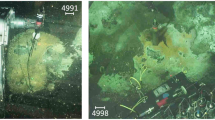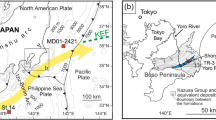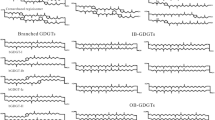Abstract
PREVIOUS investigations of fatty acids in marine sediments have primarily been concerned with the concentrations of the individual acids rather than their chemical configuration1–4. Brown and Swidler5 have demonstrated the ability of clay to catalyse the conversion of oleic acid (18:1Δ9 cis) to elaidic acid (18:1Δ9 trans) accompanied by extensive rearrangement of the double bond position. (18:1= normal carbon chain length: number of double bonds). As most biologically produced olefinic acids are believed to be in the cis configuration, diagenetic changes in the sediment may alter the cis isomers to the more stable trans isomers, as well as cause migration of the double bond. Consequently, investigations of the monounsaturated fatty acid cis/trans ratio and position of the double bonds, with depth in the sediment, may yield significant information on diagenetic pathways of these acids. We have determined the presence of small amounts of palmitelaidic acid (16:1Δ9 trans) and elaidic acid (18:1Δ9 trans), as well as other positional isomers of these trans acids, in a Recent estuarine sediment. In addition, we have also confirmed that the major monounsaturated fatty acids are palmitoleic acid (16:1Δ9 cis) and oleic acid (18:1Δ9 cis). We give here the methods for isolating these acids and confirming their structures, and their geochemical significance is discussed.
This is a preview of subscription content, access via your institution
Access options
Subscribe to this journal
Receive 51 print issues and online access
$199.00 per year
only $3.90 per issue
Buy this article
- Purchase on Springer Link
- Instant access to full article PDF
Prices may be subject to local taxes which are calculated during checkout
Similar content being viewed by others
References
Farrington, J. W., and Quinn, J. G., Geochim. cosmochim. Acta, 35, 735–741 (1971).
Farrington, J. W., and Quinn, J. G., Nature, 230, 67–69 (1971).
Farrington, J. W., and Quinn, J. G., Geochim. cosmochim. Acta, 37, 259–268 (1973).
Johnson, R. W., and Calder, J. A., Geochim. cosmochim. Acta, 37, 1943–1955 (1973).
Brown, L. H., and Swidler, R., US Pat. 2,065,248, Nov. 20, 1962; Chem. Abstr. 58, 11221F (1963).
Morris, L. J., in Metabolism and Physiological Significance of Lipids (edit. by Dawson, M. C., and Rhodes, D. N.) (Wiley, New York, 1963).
Cubero, J. M., and Mangold, H. K., Microchem. J., 9, 227–236 (1965).
McNair, H. M., and Bonelli, E. J., Basic Gas Chromatography (Varian Aerograph, Walnut Creek, 1968).
McCloskey, J. A., in Topics in Lipid Chemistry (edit. by Gunstone, F. D.) (Wiley, New York, 1970).
Silverstein, R. M., Bassler, G. C., and Morrill, T. C., Spectrometric Identification of Organic Compounds (Wiley, New York, 1974).
Downing, D. T., and Greene, R. S., Lipids, 3, 96–100 (1968).
White, A., Handler, P., and Smith, E. L., Principles of Biochemistry (McGraw-Hill, New York, 1968).
Swern, D., and Scanlan, J. T., Biochem. Prep., 3, 119–120 (1953).
Author information
Authors and Affiliations
Rights and permissions
About this article
Cite this article
VAN VLEET, E., QUINN, J. Characterisation of monounsaturated fatty acids from an estuarine sediment. Nature 262, 126–128 (1976). https://doi.org/10.1038/262126a0
Received:
Accepted:
Published:
Issue Date:
DOI: https://doi.org/10.1038/262126a0
This article is cited by
Comments
By submitting a comment you agree to abide by our Terms and Community Guidelines. If you find something abusive or that does not comply with our terms or guidelines please flag it as inappropriate.



